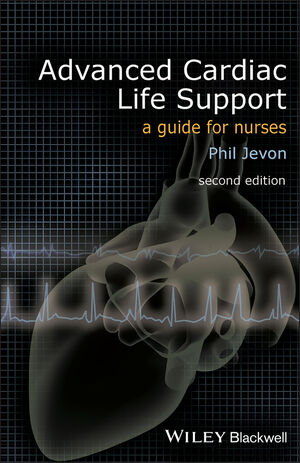Advanced Cardiac Life Support: A Guide for Nurses, 2nd EditionISBN: 978-1-4051-8566-0
Paperback
328 pages
October 2009, Wiley-Blackwell
 |
||||||
Assessment and emergency treatment of the critically ill patient 31
Chapter summary 43
Chapter 4 Principles of Cardiac Monitoring and ECG Recognition 47
Introduction 47
Learning outcomes 47
The conduction system of the heart 48
The ECG and its relation to cardiac contraction 49
Methods of cardiac monitoring 49
Problems encountered with cardiac monitoring 51
Systematic approach to ECG interpretation 52
Cardiac arrhythmias associated with cardiac arrest 56
Peri-arrest arrhythmias 58
Chapter summary 62
Chapter 5 Bystander Basic Life Support 64
Introduction 64
Learning outcomes 64
Potential hazards when attempting BLS 65
Initial assessment and sequence of actions in bystander BLS 66
Principles of chest compressions 70
Principles of mouth-to-mouth ventilation 73
The recovery position 77
Treatment for foreign body airway obstruction 81
Chapter summary 85
Chapter 6 Airway Management and Ventilation 88
Introduction 88
Learning outcomes 88
Causes of airway obstruction 89
Recognition of airway obstruction 89
Simple techniques to open and clear the airway 90
Use of oropharyngeal and nasopharyngeal airways 94
Insertion of the laryngeal mask airway (LMA) 102
Insertion of the combitube 106
Procedure for application of cricoid pressure 107
Principles of tracheal intubation 111
Methods for ventilation 116
Chapter summary 121
Chapter 7 Defibrillation and Electrical Cardioversion 124
Introduction 124
Learning objectives 125
Ventricular fibrillation 125
Physiology of defibrillation 126
Factors affecting successful defibrillation 127
Safety issues and defibrillation 132
Procedure for manual defibrillation 134
Procedure for automated external defibrillation 138
Synchronised electrical cardioversion 140
New technological advances in defibrillation 143
Chapter summary 144
Chapter 8 Advanced Life Support 147
Introduction 147
Learning objectives 147
Background to the Resuscitation Council (UK) ALS algorithm 148
Overview of the ALS algorithm 149
Chest compressions 160
Precordial thump 165
Reversible causes 167
Drug delivery routes 170
Resuscitation drugs 172
Use of pre-filled syringes 174
Principles of external pacing 176
Chapter summary 179
Chapter 9 Resuscitation in Special Situations 182
Introduction 182
Learning outcomes 182
Life-threatening electrolyte abnormalities 183
Hypothermia 186
Drowning 189
Acute severe asthma 191
Electrocution 195
Pregnancy 197
Poisoning 199
Trauma 202
Cardiovascular collapse or cardiac arrest caused by local anaesthetic 203
Chapter summary 204
Chapter 10 Anaphylaxis 209
Introduction 209
Learning outcomes 209
Definition 209
Incidence 210
Pathophysiology 211
Causes 211
Clinical features and diagnosis 211
Treatment of anaphylaxis 213
Chapter summary 217
Chapter 11 Acute Coronary Syndromes 219
Introduction 219
Learning outcomes 219
Pathogenesis of ACS 219
Classification of ACS 220
Diagnosis of ACS 221
Immediate treatment of ACS 228
Chapter summary 232
Chapter 12 Management of Peri-Arrest Arrhythmias 234
Introduction 234
Learning outcomes 234
Principles of the use of the peri-arrest algorithms 235
Adverse clinical signs associated with peri-arrest arrhythmias 235
Management of bradycardia 236
Management of a tachycardia 238
Chapter summary 242
Chapter 13 Post-Resuscitation Care 244
Introduction 244
Learning objectives 244
Goals of post-resuscitation care 245
Initial assessment priorities 245
Transfer to definitive care 253
Measures to limit damage to vital organs 254
Temperature control and therapeutic hypothermia 257
Prediction of poor outcome 262
Chapter summary 263
Chapter 14 Bereavement 266
Introduction 266
Learning objectives 266
Ideal layout for the relatives room 266
Breaking bad news 267
Telephone notification of relatives 268
Practical arrangements following a death 269
Relatives witnessing resuscitation 270
Chapter summary 272
Chapter 15 Ethical Issues in Resuscitation 273
Introduction 273
Learning outcomes 274
Ethical principles that guide medical practice 274
Historical background to DNAR decisions 275
Importance of DNAR decisions 277
Key messages in Decisions Relating to Cardiopulmonary Resuscitation 278
Overview of the DNAR decision-making process 279
Factors underpinning DNAR decisions 279
Documentation of DNAR decisions 286
Information for patients and relatives 287
Chapter summary 288
Chapter 16 Resuscitation Records 291
Introduction 291
Learning outcomes 291
Why maintaining accurate resuscitation records is important 291
Examples of poor record keeping 292
Factors underpinning effective record keeping 292
Importance of auditing resuscitation records 294
Legal issues associated with record keeping 294
Audit and reporting standards 295
Chapter summary 296
Chapter 17 Resuscitation Training 297
Introduction 297
Learning outcomes 297
Why resuscitation training is important 298
Principles of adult learning 298
Resuscitation training methods 299
Recommendations for resuscitation training for healthcare staff 302
Training mannequins/models 304
Resuscitation Council (UK) courses 304
Chapter summary 306
Index 309



